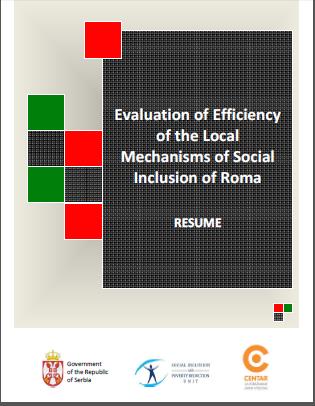Evaluation of Efficiency of the Local Mechanisms of Social Inclusion of Roma
This project resulted in recommendations for efficient and sustainable work of the local mechanisms for the social inclusion of Roma in the Republic of Serbia. The CENTAR research team analyzed the work of the existing mechanisms - health mediators, pedagogical assistants, Roma coordinators, advisors at the National Employment Service and the social care centers in municipalities where they all exist.
The research was conducted in cooperation and with the support of Social Inclusion and Poverty Reduction Unit (SIPRU) of the Government of the Republic of Serbia.
Since 2002 the Republic of Serbia has adopted a number of policy documents aimed at comprehensive approach to the problems of the Roma population in Serbia and coming to solutions to improve their position. In 2003 the National Council of the Roma minority was established while in 2005 Serbia has ratified the Decade of Roma Inclusion 2005-2015, which Serbia also chaired during 2008/2009. In 2009 the Government of the Republic of Serbia adopted Strategy for improving of the situation of Roma, after which the Action plans were approved for the period 2009-2011 and 2012-2014. The strategy keeps focus on education, housing, health protection and employment of Roma population, while other priorities include fight against discrimination, fight against poverty and the issue of gender equality. Key sectoral documents include Action Plan for Employment of Roma (2004), Strategy for improvement of Roma education and Plan for health protection of Roma population (2006).
While the strategic framework is mostly completed, implementation of strategies and plans in the municipalities remains fragmented and depends on the engagement of local authorities. Some municipalities have developed their own plans to improve Roma education (Sombor, Subotica, Valjevo, Kragujevac, Pirot, Nis, Kraljevo, Negotin). Program for Roma pedagogical assistants is implemented in the approximately 60 primary schools in Serbia. At the same time, 75 health mediators help in solving the problem of health protection of Roma people in 59 municipalities. Number of Roma coordinators has increased and currently there is 55 coordinators. They are all budgeted from municipal budgets but their job descriptions differ from municipality to municipality.
Still, most municipalities implement only one or two programs, and only around 20 municipalities are applying all these programs. The CENTAR research team was dealing with the municipalities where all the mechanisms are in place, in order to identify the necessary standards and processes that enable the successful inclusion of Roma in the local community.
The results are available in Serbian and English at the websites of the CENTAR and the SIPRU.






